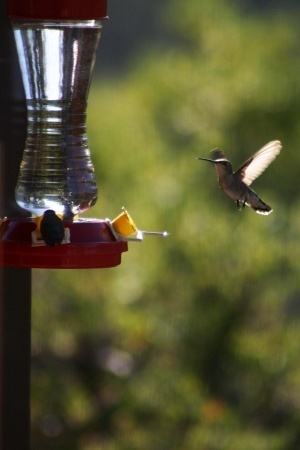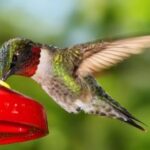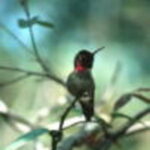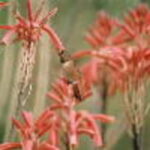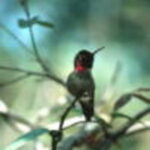New Mexico is known for its many wonders, from the cool, cool pines that call the mountains home to its caverns at Carlsbad and all that lies in between. But bird watchers, hummingbird enthusiasts to be more specific, may have an even greater interest in this state because of the seventeen species of hummingbirds that visit it each year on their migration trail. These seventeen species are the Black-chinned Hummingbird, the Broad-tailed Hummingbird, the Rufous Hummingbird, the Calliope Hummingbird, the Broad-billed Hummingbird, the Violet-crowned Hummingbird, the Costa’s Hummingbird, the Anna’s Hummingbird, the Magnificent Hummingbird, the Ruby-throated Hummingbird, the Blue-throated Hummingbird, the White-eared Hummingbird, the Lucifer Hummingbird, the Cinnamon Hummingbird, the Berylline Hummingbird, the Allen’s Hummingbird and the Plain-capped Starthroat Hummingbird.
Now that the number of species of hummingbirds in New Mexico has been documented by the folks in charge of these types of things, the real task at any hummingbird feeder or hummingbird garden can begin, which is, of course, identifying the species of hummingbird that is visiting. Unless the task of putting up the hummingbird feeder or installing a hummingbird garden has yet to be completed. Therefore, addressing these two issues, the hummingbird garden and hummingbird feeder, may be important, and this is the perfect time to start.
Hummingbird feeders are available in various sizes and shapes, and of course, price. But from my own experience, the hummingbirds I have that visit me each year, really prefer my old cheapo, dollar store hummingbird feeders better than the expensive one I just had to have, hard to believe, huh? Therefore, the price of the hummingbird feeder does not necessarily determine its worth to the hummingbirds. Okay, what should be put into that hummingbird feeder? The answer to this question is simple, all it needs is a simple water and sugar solution, again, no fancy store bought red nectar stuff. To create this sugar- water solution, simply add ¼ cup of sugar to 1 cup of water, bring to a boil, allow to cool off, then pour in to the feeder. Repeating this procedure is necessary at least once a week, maybe more often as the temperatures increase.
Hummingbird gardens are also available in various sizes and shapes, just like the hummingbird feeders. But unlike the hummingbird feeders, the size and shape of a hummingbird garden is often determined by the time and money the hummingbird enthusiast has to invest in it. Even though size and shape are important to the human factor of the garden, they are not important to the hummingbird factor. What is important to them are the plants that are included in that garden, which are annuals, vines, perennials, shrubs and tree. Hummingbirds in New Mexico will appreciate hummingbird gardens that include annuals such as snapdragon, tiny trumpet, impatiens, scarlet sage and nasturtium. Perennials they are attracted to are columbine, Wyoming paintbrush, giant red paintbrush, fireweed, scarlet gilia, scarlet lychnis, horsemint, Penstemon and longleaf phlox. Vines to include in the hummingbird garden are red morning glory, orange honeysuckle and trumpet honeysuckle. Shrubs and trees to include in a New Mexico hummingbird garden are green-leaf manzanita, Siberian pea, flowering quince, twinberry, flowering currant, blueberry, Russian olive, flowering crab, chokecherry, catalpa and black locust.
Identifying the visiting hummingbirds in New Mexico can begin once the birds make their appearance at these hummingbird feeders and gardens. This identification occurs generally by paying close attention to the colors of the feathers that cover the tiny bird.
The Black-chinned Hummingbird male has a black throat with a purple throat band and a white collar; it also has a white breast and black, pointed tail feathers. The Black-chinned Hummingbird female is less colorful with its pale gray belly, dullish green back, pale gray crown and banded gray, black and white, pointed tail feathers.
The Broad-tailed Hummingbird male has a throat that ranges in color from hot pink to rosy red, its back is green, its breast is white and it has a pointed tail with blunt outer feathers that are black with a narrow rusty colored edge. The female Broad-tailed Hummingbird’s belly is pale rust and white, its back is green, its throat is pale green and bronze green and its outer tail feathers are banded rust, black and white.
The Rufous Hummingbird male has a throat that ranges in color from red-orange to yellow-orange, its back is rufous or rust colored as are its rump and upper tail feathers. The female Rufous Hummingbird has a belly that is rufous and cream colored and her throat has an iridescent orange patch located in the center. Her tail feathers are rufous, black and white and her tail is rounded, unlike her male counterpart who’s tail is pointed.
The Calliope Hummingbird male has a throat that is white with red wine colored streaks, its breast is white, its back is green and its outer tail feathers are gray. The female Calliope Hummingbird is less colorful than her male counterpart with her breast that is light rufous and white, a green back and her throat is light cream colored with some bronze green. This female hummingbird also has tail feathers that are gray, black, white and rufous and her tail very short, usually not any longer than her wings.
The Broad-billed Hummingbird male has a throat that shimmers a cobalt blue color and extends down into a breast and upper belly that are deep emerald green while the lower belly is light to medium gray. The tail feathers on this male hummingbird are steel blue and are bordered in dark gray and his bill is red and black. The female Broad-billed Hummingbird is another female that is less colorful than the male of the species with her light to medium gray throat, breast and belly, her bluish-black and white tail and here green back and crown.
The Violet-crowned Hummingbird are somewhat different than most species of hummingbirds in New Mexico, because they are virtually marked the same. The both have white breasts and bellies, their crowns are bright blue-violet, they have a red bill with a black tip and their back and tail are grayish-green to bronze-green.
The Costa’s Hummingbird male has a purple throat and crown, a green breast and a metallic green back as well as very long green feathers down the side of his throat. The female Costa’s Hummingbird is not as brightly colored as the male, but does have a green back and crown, white breast and a throat that is white and black spotted.
The Anna’s Hummingbird male has a throat that is rose red to coppery red with long corner feathers and a crown that is the same color as its throat. This male hummingbird also has a gray breast and a long tail that is gray and blunt-tipped. In contrast to the male Anna’s Hummingbird, the female Anna’s Hummingbird has a green back, gray belly and breast a small patch of red or copper colored feathers in the middle of her throat when she is mature and her tail feathers are banded gray, black and white.
The Magnificent Hummingbird male has a bright turquoise green throat, purple crown, white triangle behind the eye, black breast, green back, and bronze-green notched tail. The female Magnificent Hummingbird has a gray throat and belly, white triangle behind the eye like the male, and banded bronze-green tail feathers.
The Ruby-throated Hummingbird male has a ruby colored throat, a white collar, emerald green back and a forked tail. The female Ruby-throated Hummingbird is duller in comparison to the male, but does have a whitish belly and breast, a green back and its tail feathers are banded white, black and gray-green.
The Blue-throated Hummingbird has a bright blue throat, a white stripe behind its eyes, gray cheeks, bright green crown and shoulders and a blackish rump. The female Blue-throated Hummingbird is similar to the male in that it has a white stripe behind its eye, gray cheeks, bright green crown and shoulders and a black rump, but it differs with its gray throat.
The White-eared Hummingbird male has a turquoise throat, turquoise and white spotted breast and flanks, a deep green back, a white belly and breast and a wide violet-blue band on a short, thin red and black bill. The White-eared Hummingbird female has a white or cream colored throat that is speckled with green, a white belly, deep green crown and a drab green back. Both the male and female White-eared Hummingbird have a prominent white ear stripe that lends itself to the name of this species of hummingbirds.
The Lucifer Hummingbird male has magenta to blue-violet throat, a white breast and neck and dark outer tail feathers. The female Lucifer Hummingbird has a rust belly and breast, a dark line behind her eyes and tail feathers that are rust, black and white.
The Cinnamon Hummingbird is one of the few species of hummingbirds in New Mexico that, when identifying them, there is no real difference between the males and females. This species of hummingbird does not have the spectacular colored throat, instead, it is cinnamon colored from below its eye, down its throat, down its breast and on to under its tail feathers. On the top side there is green feathers beginning at the cinnamon color under the eye and traveling over the eye, across the crown and down the back to the rump where the green blends in with rufous feathers on the tail feather, which has some green iridescence to it.
The Berylline Hummingbird is another species of hummingbirds in New Mexico that has little noticeable difference between the sexes when trying to identify them. These hummingbirds have shimmering green feathers that cover their body, extending from their bill to their rump, where the color changes to rufous and extends through their tail feathers. The tail feathers on these tiny birds have a shiny, iridescent purple tint that blends with the rufous color, creating an identification feature that sets them apart from other hummingbirds in New Mexico.
The Allen’s Hummingbird male has a throat that ranges in color from orange-red to yellow-orange, a back that is bright green, a rump that is rufous and its tail feathers are rufous tipped in black. The female Allen’s Hummingbird closely resembles the female Rufous Hummingbird, with a crown that is green, a breast that is white, a throat that is streaked and tail feathers that are rufous tipped in white. The only noticeable difference between the female Allen’s Hummingbird and the female Rufous Hummingbird is that the female Allen’s Hummingbird has narrower tail feathers, thus they are almost impossible to tell apart.
The Plain-capped Starthroat Hummingbird is one more of the hummingbirds in New Mexico that there is little difference between the sexes when identifying them. The main identifying features of this species of hummingbird is its size, which ranges between 7 and 8 grams, and it has a very long bill. Other identifying features include a very dark, dull throat, maybe violet-red in color, a white eye stripe above and below the eye, a white patch on its rump and back and a gray breast and belly.
